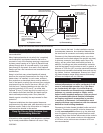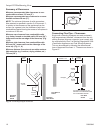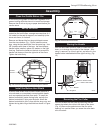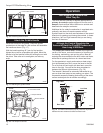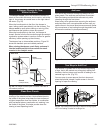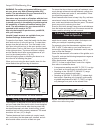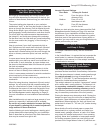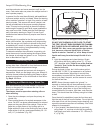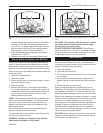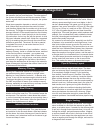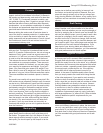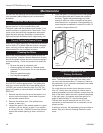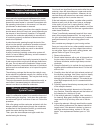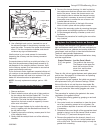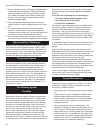
17
Intrepid II Woodburning Stove
30003840
Continue adding split logs of this size to the briskly-
burning fire until there is a glowing ember bed at
least 76 mm (3”) deep. A good ember bed is neces-
sary for proper functioning of the catalytic system
and may take an hour or more to establish.
5. Close the damper when the griddle temperature
reaches 230° C (450° F).
6. Adjust the air control for your desired heat output.
Refuel While the Embers are Still Hot
Reload the Intrepid II while it is still hot and there are
plenty of glowing embers to re-kindle the fire. Include
some smaller pieces of wood in the new load of fuel to
help the stove rebuild its operating temperature quickly.
Wear stove gloves, and follow this procedure when you
reload your stove:
1. Open the thermostat lever.
2. Open the damper.
3. Check the ash level in the ash pan; empty, if neces
-
sary, and replace the pan.
4. Open the griddle.
5. Position the charcoal in the middle of the firebox
(Fig. 41)then load wood — smaller, split pieces first.
Increase the amount of fuel you load into the stove
as you become familiar with your stove and the
heating needs of your home.
NOTE: If the remaining charcoal bed is relatively thick
and if your fuel is well seasoned, it is possible to add
fresh fuel (smaller pieces first), close the door and
damper, and reset the primary air thermostat for the
desired heat output.
Do not break the charcoal into very small pieces or
pound or compress the charcoal bed.
It is important that air can circulate under the wood for
the fire to be quickly revived.
WARNING: Operate your Intrepid II only with the
doors either fully open or fully closed.
ST264
good fire
12/99
ST264
Fig. 26 Add larger pieces of wood as the fire begins to burn
well.
ST264a
add wood fire
11/00
ST264a
Fig. 27 Add full size logs when the ember bed is 3” (75mm)
deep.
CAUTION: The Intrepid II will be hot while in opera-
tion. Keep children, clothing and furniture away.
Contact may cause skin burns.
DO NOT OVERFIRE THIS HEATER. Overfiring may
cause a house fire, or can result in permanent damage
to the stove and to the catalytic combustor. If any part
of the Intrepid II glows, you are overfiring.
Ash Disposal
Remove ash before it reaches the top of the ash pan.
Check the level at least once a day, and before each
re-fueling. If the ash is close to the top edge of the pan,
empty it according to this procedure:
1. Open the damper.
2. Open the front doors fully.
3. Using stove gloves, pull the ash pan out of the stove
by its handle.
4. Remove the ash pan and properly dispose of the
ashes. Be sure to keep the pan level during dispos-
al.
5. Return the ash pan to the stove.
Empty the ash pan regularly, typically every one to
three days. The frequency will vary depending on how
you operate your Intrepid II; if you burn more wood at
higher heat output settings, ash will accumulate rapidly.
Remove ash frequently and place it outdoors in a metal
container with a tight-fitting lid. Put the closed container
of ash on a noncombustible floor or on the ground,
well away from all combustible materials, pending final
disposal. If the ash is disposed of by burial in soil or
otherwise locally dispersed, keep it in the closed con-
tainer until all cinders have thoroughly cooled. You can
use wood ash as a garden fertilizer.
CAUTION: Never use your household or shop vacuum
cleaner to remove ash from the stove; always remove
and dispose of the ash properly.



